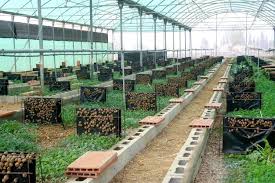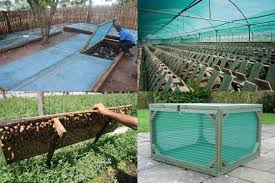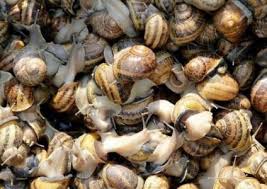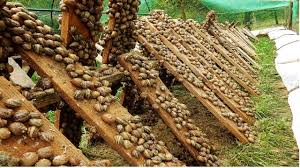Snail farming techniques encompass a range of practices designed to optimize the growth and production of snails for culinary and commercial purposes.
This agricultural method, known as heliciculture, has gained significant traction worldwide due to its sustainability, low environmental impact, and high market demand for snail meat and byproducts such as slime. Snails are rich in protein and low in fat, making them an attractive food source in various cuisines.
Additionally, their slime is increasingly used in the cosmetics industry for its moisturizing and regenerative properties, further driving interest in snail farming.
The global market for snails is expanding, fueled by an increasing interest in exotic foods and health-conscious diets.
Countries like France, Spain, and Italy have long embraced snail farming, and now regions in North America and Asia are following suit. As consumer awareness about the benefits of snails grows, more farmers are considering entering this profitable venture.
Successful snail farming requires a comprehensive understanding of the snails’ biology, habitat, and specific care requirements. Several key factors must be considered when starting a snail farm, including the choice of snail species, the farming environment, feeding strategies, and pest management.
The most commonly farmed species include the African giant land snail (Achatina fulica) and the European brown snail (Helix aspersa), each with unique advantages and growth conditions.
Choosing the appropriate snail species is crucial for successful farming. The African giant land snail is renowned for its rapid growth rate and large size, making it a popular choice among farmers.
In contrast, the European brown snail is favored for its culinary value and established market. Understanding market demand and growth conditions for each species is essential for making informed decisions.
The farming environment significantly impacts snail health and growth. Snails thrive in humid, warm conditions, so it’s essential to create an environment that mimics their natural habitat.
This includes providing adequate shelter, maintaining appropriate temperature and humidity levels, and ensuring proper drainage to prevent waterlogging. Many farmers utilize indoor systems or controlled environments to effectively manage these factors.
Nutrition and feeding are critical aspects of snail farming. Snails are herbivores, primarily consuming leafy greens, fruits, and vegetables.
A balanced diet is essential for their growth and reproduction, and farmers often supplement their diets with calcium-rich foods to promote shell development.
Understanding the nutritional needs of snails and providing a diverse diet can lead to healthier snails and increased production.
Effective pest management and disease control are vital components of snail farming. Snails are susceptible to various pests, such as slugs and rodents, which can threaten their survival and productivity.
Implementing integrated pest management strategies such as proper sanitation, habitat management, and introducing natural predators—can help control these threats.
Additionally, monitoring for diseases and maintaining proper hygiene in the farming environment can prevent outbreaks that could jeopardize the entire farm.
Snail farming techniques offer an exciting opportunity for entrepreneurs interested in sustainable agriculture and alternative protein sources. By understanding the various methods and practices involved in snail farming, individuals can establish successful operations that meet growing market demands.
With the right knowledge and management practices, snail farming can be a rewarding venture, contributing to food security and economic development.
Understanding Snail Species Suitable for Farming
When starting a snail farm, it’s essential to choose the right species that are well-suited for farming. Here are some common snail species recommended for farming:
1. African Giant Snail (Achatina fulica): This species is popular for its large size and rapid growth. It is highly sought after in the culinary market and has a good meat yield.
2. Helix aspersa (Common Garden Snail): This species is known for its adaptability and is commonly used in escargot dishes. It has a slower growth rate but can be farmed in various climates.
3. Cornu aspersum (European Brown Snail): Similar to the common garden snail, this species is widely consumed in Europe. It thrives in cooler climates and can be a good option for temperate regions.
4. Eobania vermiculata: This species is smaller than the African Giant Snail but is resilient and can adapt to various farming conditions. It is primarily farmed for local markets.
5. Pomacea canaliculata (Apple Snail): Although primarily known for its aquatic nature, some farmers raise this species for both food and ornamental purposes.
Benefits of Snail Farming

Snail farming offers various advantages that make it an attractive agricultural practice. Here are the key benefits:
1. High Demand: Snails are considered a delicacy in many cultures, leading to high market demand, especially for species like the African Giant Snail.
2. Low Capital Investment: Starting a snail farm requires relatively low initial investment compared to other livestock. Snails do not need extensive housing or special feeding.
3. Sustainable Farming: Snails are environmentally friendly as they have a low carbon footprint and require less water compared to traditional livestock. They also contribute to soil health by naturally fertilizing the ground.
4. Nutritional Value: Snail meat is high in protein and low in fat. It is also rich in essential nutrients such as iron, magnesium, and vitamins, making it a healthy food choice.
5. Quick Return on Investment: Snails have a short reproductive cycle, with some species capable of breeding within six months. This rapid turnover can lead to quick profits for farmers.
Choosing the Right Location for Your Snail Farm
Selecting an appropriate location is crucial for successful snail farming. Here are essential factors to consider:
1. Climate: Snails thrive in humid, warm environments. Ideal temperatures range from 20°C to 30°C (68°F to 86°F). Choose a location with adequate rainfall or be prepared to provide additional moisture.
2. Accessibility: Ensure the site is easily accessible for transporting snails and supplies. Proximity to markets can also help reduce transportation costs.
3. Soil Quality: Snails prefer well-draining soils rich in organic matter. Conduct a soil test to ensure it meets the necessary nutrient requirements.
4. Safety from Predators: Choose a location that minimizes exposure to predators such as birds, rodents, and other animals that might harm the snails.
5. Availability of Resources: Ensure access to water and food sources, such as plants and vegetation, which are essential for the snails’ diet.
Read Also: Tangerine and Mandarin Branches: Economic Importance, Uses and By-Products
Designing Your Snail Farming Environment

Creating a suitable environment for your snail farm is vital for their health and productivity. Here are key design elements to consider:
1. Housing: Snails need shelter to protect them from extreme weather and predators. Design housing that provides shade and moisture. Use materials like wood or plastic to create a comfortable environment.
2. Enclosure: Build a secure enclosure to keep snails contained and prevent escape. Use materials that are durable and resistant to moisture. The enclosure should also allow for proper ventilation.
3. Soil Preparation: Prepare the soil by tilling and enriching it with organic matter. Ensure the soil pH is between 6.5 and 7.5 for optimal growth. Regularly monitor soil health to maintain a nutrient-rich environment.
4. Moisture Control: Snails require a humid environment. Use mulch or organic materials to retain moisture in the soil. Regularly spray water to maintain humidity, especially during dry periods.
5. Feeding Area: Designate specific areas for feeding snails to prevent overcrowding and competition for food. Offer a balanced diet consisting of leaves, fruits, and vegetables.
6. Water Source: Provide a shallow water source for snails to drink and stay hydrated. Ensure the water is clean and free from contaminants.
Soil Preparation and Maintenance for Snails
Soil quality is crucial for snail farming, as it directly affects their growth and health. Here are the steps for proper soil preparation and maintenance:
1. Soil Selection: Choose well-drained, loamy soil rich in organic matter. Snails thrive in soil that retains moisture without becoming waterlogged.
2. Soil Testing: Conduct a soil test to determine pH and nutrient levels. Snails prefer a slightly acidic to neutral pH (between 6.5 and 7.5). Adjust the soil pH if necessary by adding lime to raise it or sulfur to lower it.
3. Soil Enrichment: Add organic matter, such as compost or well-rotted manure, to improve soil fertility. This enhances nutrient availability and provides a conducive environment for snails.
4. Tilling the Soil: Tilling helps aerate the soil and incorporate organic matter. Break up compacted soil to create a loose, crumbly texture that allows snails to burrow easily.
5. Moisture Management: Maintain adequate moisture levels in the soil, as snails require a humid environment. Regularly check soil moisture and irrigate if necessary, especially during dry seasons.
6. Regular Maintenance: Periodically remove debris and weeds from the snail farm to prevent diseases and pests. Keeping the environment clean promotes healthy snail growth.
Setting Up Shelters and Housing for Snails
Providing suitable housing for snails is essential for their protection and growth. Here are important steps for setting up shelters:
1. Shelter Design: Snail shelters can be constructed using various materials, such as wood, plastic, or metal. Ensure that shelters are well-ventilated and have sufficient space for snails to move around comfortably.
2. Location Selection: Choose a shaded area for snail housing to protect them from direct sunlight, which can cause stress and dehydration. Natural shade from trees or artificial shade structures can be effective.
3. Floor Covering: Line the floor of the shelter with a layer of moist substrate, such as straw or grass. This helps retain humidity and provides a comfortable environment for snails.
4. Temperature Control: Maintain an optimal temperature range (around 18°C to 25°C or 65°F to 77°F) in the shelter. Use insulation materials to regulate temperature, especially in extreme weather conditions.
5. Nesting Areas: Provide nesting areas using materials like coconut coir or sawdust, which allow snails to lay eggs. Ensure these areas are kept moist to promote egg development.
6. Access to Water: Ensure that snails have access to clean, shallow water dishes to drink from. Regularly change the water to keep it fresh and free from contaminants.
Read Also: Monkeys: Species and Rare Interesting Facts
Nutritional Requirements of Snails

Proper nutrition is vital for the growth and health of snails. Here’s what you need to know about their nutritional needs:
1. Calcium Sources: Calcium is essential for snail shell development. Provide calcium-rich foods, such as crushed oyster shells, limestone, or eggshells, to ensure snails receive adequate calcium.
2. Green Vegetables: Snails thrive on a diet rich in leafy greens, such as lettuce, kale, and spinach. These vegetables provide essential vitamins and minerals for overall health.
3. Protein Sources: Incorporate protein sources into the snail diet, such as soybean meal, fish meal, or commercial snail feed. Protein supports growth and reproduction.
4. Fruits and Carbohydrates: Offer fruits like apples, pears, and bananas as treats. These provide carbohydrates and moisture but should be given in moderation to prevent overfeeding.
5. Nutritional Balance: Maintain a balanced diet by ensuring that snails receive all necessary nutrients. A well-rounded diet promotes healthy growth and reproduction.
6. Water and Moisture: Ensure that snails have access to moisture-rich foods and water. Snails absorb moisture through their skin and require a humid environment for optimal health.
Feeding Techniques for Optimal Growth
Implementing effective feeding techniques is crucial for the successful growth of snails. Here are some practical feeding methods:
1. Regular Feeding Schedule: Establish a consistent feeding schedule, offering food once or twice a day. Regular feeding helps snails maintain a healthy growth rate.
2. Portion Control: Monitor the quantity of food offered to avoid overfeeding. Start with small portions and adjust based on snail consumption. Remove any uneaten food to prevent spoilage.
3. Variety in Diet: Provide a variety of food sources to ensure balanced nutrition. Rotate different types of greens, fruits, and protein sources to prevent boredom and encourage healthy eating habits.
4. Moisture Control: Keep the food moist but not soggy. Dry or moldy food can harm snails. Store food in a cool, dry place and regularly check for freshness.
5. Monitoring Growth: Regularly monitor snail growth and adjust the diet as necessary. Observing changes in growth rates can help identify any dietary deficiencies.
6. Clean Feeding Area: Maintain a clean feeding area by regularly cleaning up leftover food and waste. This prevents the buildup of harmful bacteria and promotes a healthy environment for snails.
Water Management in Snail Farming
Water management is crucial for snail farming, as snails require a humid environment to thrive. Here are important practices for effective water management:
1. Moisture Retention: Snails thrive in environments with high humidity. Maintain adequate moisture levels in the soil and shelters by regularly watering the area and ensuring proper drainage to prevent waterlogging.
2. Water Sources: Provide clean water sources for snails to drink and soak. Shallow water dishes or containers can be used, ensuring they are not too deep to avoid drowning.
3. Regular Monitoring: Regularly check humidity levels in the snail farming area. Using a hygrometer can help monitor moisture levels. Ideal humidity should be around 70% to 90%.
4. Rainwater Harvesting: Consider using rainwater harvesting systems to collect and store rainwater. This sustainable method ensures a consistent supply of clean water for snails.
5. Avoiding Water Pollution: Ensure that water sources are clean and free from contaminants. Regularly clean water dishes and change the water to prevent bacterial growth.
6. Soil Moisture Management: Use organic mulches, such as straw or leaves, to help retain soil moisture. This practice reduces evaporation and keeps the soil damp for snails.
Breeding Techniques for Snails
Successful snail farming heavily relies on effective breeding techniques. Here are some essential practices for breeding snails:
1. Selection of Breeding Stock: Choose healthy, mature snails for breeding. Look for individuals with well-formed shells and active behavior. Select snails of the same species for cross-breeding.
2. Creating Breeding Conditions: Establish a separate breeding area that provides optimal conditions, including humidity, temperature, and shelter. Ideal breeding temperatures range from 20°C to 25°C (68°F to 77°F).
3. Mating Process: Introduce the selected breeding snails into the breeding area. Snails are hermaphrodites, meaning they have both male and female reproductive organs, so they can mate with any other adult snail.
4. Egg-Laying Environment: Provide suitable nesting areas for egg-laying, using damp soil or substrate. Snails usually lay eggs a few weeks after mating, typically in clutches of 30 to 100 eggs.
5. Incubation Conditions: Maintain the breeding area’s humidity and temperature for optimal egg incubation. Keep the soil consistently moist but not overly wet.
6. Monitoring Hatchlings: After about 2 to 4 weeks, the eggs will hatch. Carefully monitor the hatchlings, ensuring they have access to food and moisture.
Pest and Disease Management in Snail Farming
Effective pest and disease management is essential for maintaining healthy snail populations. Here are key strategies to manage pests and diseases:
1. Identifying Common Pests: Common pests in snail farming include slugs, snails, and certain insects. Regularly inspect the farming area for signs of pest infestation.
2. Natural Pest Control: Utilize natural predators, such as birds and beneficial insects, to control pest populations. Encourage their presence by planting diverse vegetation around the farm.
3. Cultural Practices: Implement good agricultural practices, such as rotating snail farming sites, to disrupt pest life cycles. Maintaining cleanliness in the farming area reduces pest habitats.
4. Disease Monitoring: Regularly monitor snails for signs of disease, such as lethargy, abnormal behavior, or shell deformities. Quick identification is key to effective treatment.
5. Quarantine Measures: Isolate new snails or those showing signs of illness to prevent the spread of disease. Observe them for a period before introducing them to the main population.
6. Veterinary Care: Consult a veterinarian with expertise in mollusks if you suspect a disease outbreak. They can provide guidance on treatment and preventive measures.
Harvesting Snails: Timing and Methods
Proper harvesting techniques are crucial for maximizing yield and ensuring quality. Here are the key considerations for harvesting snails:
1. Timing of Harvest: Snails are typically ready for harvest after 6 to 12 months, depending on the species and growing conditions. Harvest when snails reach marketable size, usually around 50-100 grams.
2. Harvesting Methods: Gently collect snails by hand or using specialized tools to avoid damaging their shells. Avoid disturbing the soil excessively to prevent stress to remaining snails.
3. Post-Harvest Handling: After collection, place snails in clean containers lined with damp cloth or paper to maintain humidity. Keep them in a cool, shaded area to prevent overheating.
4. Cleaning Snails: Before selling, clean snails by rinsing them in fresh water to remove any soil or debris. Ensure they are in a well-ventilated area during this process.
5. Storage Conditions: Store harvested snails in a cool, dark environment until they are sold. Proper storage conditions help maintain their quality and freshness.
6. Market Considerations: Consider local market demand when planning harvests. Properly packaged and presented snails can fetch better prices in the market.
Do you have any questions, suggestions, or contributions? If so, please feel free to use the comment box below to share your thoughts. We also encourage you to kindly share this information with others who might benefit from it. Since we can’t reach everyone at once, we truly appreciate your help in spreading the word. Thank you so much for your support and for sharing!
Read Also: How to Make Money from Plastic Recycling






